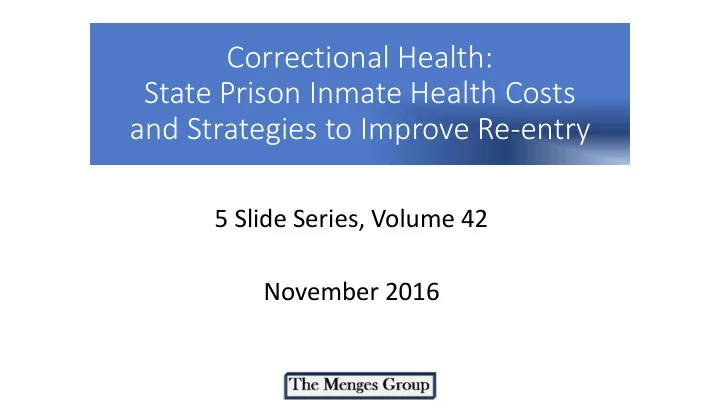

Correctional Health: State Prison Inmate Health Costs and Strategies to Improve Re-entry 5 Slide Series, Volume 42 November 2016
State Prisons and Inmate Population in Each Medicaid Expansion State Data source for # of inmates: “Prisoners in # Inmates # Inmates as 2012: Trends in Admissions and Releases, # State as of Dec # State of Dec 31, 1991 –2012,” U.S. Department of Justice, State Prisons 31, 2012 State Prisons 2012 September 2014. Minnesota 15 9,938 Alaska 15 2,974 Arizona 16 38,402 Nevada 10 12,744 This source report shows there are Arkansas 18 14,615 New Hampshire 4 2,790 1,314,906 inmates at state prisons as of New Jersey 13 23,225 California 34 134,211 December 31, 2016. Almost exactly half of New Mexico 11 6,574 Colorado 25 20,462 these persons (50.6%) were inmates in Connecticut 20 11,961 New York 59 54,073 Delaware 13 4,129 North Dakota 5 1,512 Medicaid expansion states. Hawaii 8 3,819 Ohio 32 50,876 Illinois 48 49,348 Oregon 21 14,801 This source also shows that 581,374 Indiana 22 28,822 Pennsylvania 25 50,918 persons were released from state prisons Iowa 9 8,686 Rhode Island 7 1,999 during the entirety of CY2012. Kentucky 15 21,466 Vermont 9 1,516 Louisiana Washington 12 17,254 10 40,170 Maryland 28 21,281 West Virginia 15 7,027 These figures exclude inmates in county Massachusetts 18 9,999 Total 29 States 537 665,592 jails and Federal prisons. 2
Volume of Persons Released from State Prisons in Medicaid Expansion States • Per the data shown on previous slide, approximately 650,000 persons are inmates in state prisons in jurisdictions where Medicaid expansion has been implemented. • Based on nationwide ratio of the number of released individuals to the baseline inmate population, we estimate that just under 300,000 state prison inmates are released to the community across the Medicaid expansion states annually. • Nearly all state prisoners in Medicaid expansion states are eligible for Medicaid at the point of release. • Important opportunities exist to design and deliver tailored care coordination to these individuals within Medicaid’s benefits structure. States are increasingly recognizing the opportunities Medicaid coverage offers to support successful re-entry, reduce recidivism and improve population health. 3
Examples of Care Coordination Components • Take full advantage of known upcoming release date to conduct planning activities to facilitate an inmate’s effective transition • Line up Medicaid eligibility and, where applicable, enrollment into a Medicaid MCO and selection of a primary care provider • Establish individualized care plan regarding action steps that will occur upon release (including facilitating ongoing clinical care and communication with the ex-inmate, justice system personnel, caregivers, and key providers) • Comprehensive assessment of clinical needs, medication regimen, etc. as well as family/community supports and established provider relationships • Schedule initial appointments with key providers (PCP, behavioral health and substance abuse specialists/programs, etc.) • Initiate relationship with care coordinator -- an employee of an MCO, the Medicaid agency, or a contractor working with the Medicaid agency) 4
Potential Program Evaluation Components • Initiative can be piloted rather than immediately implemented on a large scale (e.g., for persons being released from selected facilities) • Impact evaluation can include assessment of Medicaid’s total cost (and component costs) for target population versus identified control group. Other evaluation metrics can include recidivism, participant satisfaction, employment rate, etc. • Medicaid spending for this tailored care coordination program will largely involve Federal dollars (currently the Federal share of Medicaid Expansion enrollee costs is 95% for medical services and 50% for program administration) • Net savings may well occur strictly within confines of Medicaid • Favorable state fiscal impacts may also occur through reduced crime and recidivism (lowering future correctional health outlays), as well as increased state revenue through employment 5
5 Slide Series Overview Our 5 Slide Series is a monthly publication whereby we briefly discuss/address a selected topic outside the confines of our client engagements. We strive to create new information in each edition – through our own data tabulations and/or through conveying our ideas and opinions. To be added to our list to receive these as they are published (or to be removed), please email us at jmenges@themengesgroup.com or call 571-312-2360. Address: 4001 9 th Street N., Suite 227, Arlington VA 22203 Website: www.themengesgroup.com Poornima Singh, Vice President, directs our Correctional Health practice group. Her contact information is: psingh@themengesgroup.com; 202-680-2571 6
Recommend
More recommend